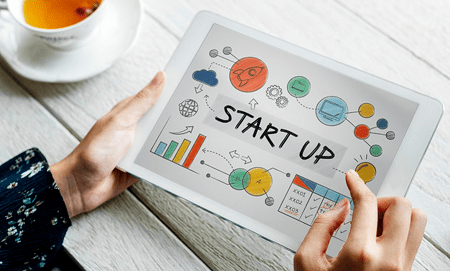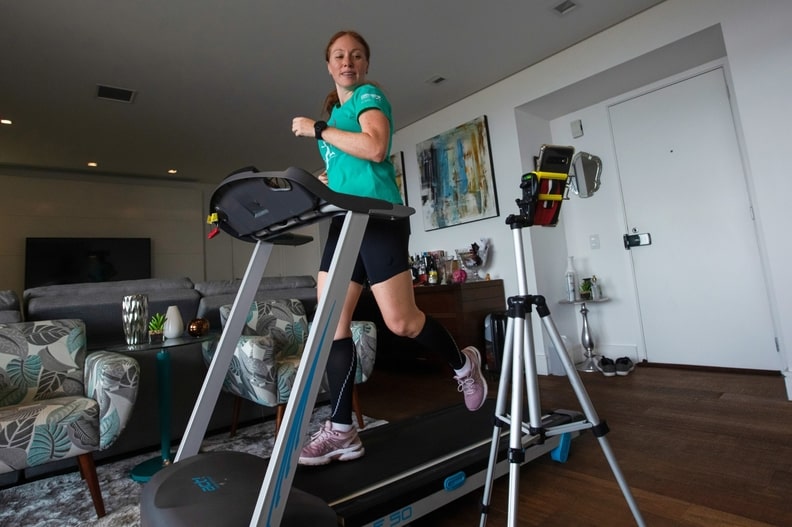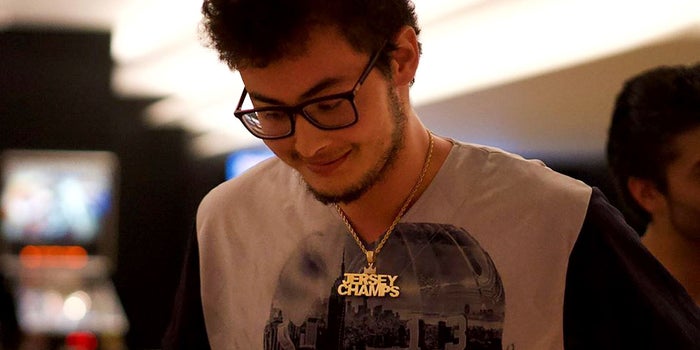By Katie Sehl,
Like most social media trends, Instagram trends move quickly. And in 2020, change has been fast and furious, with a global pandemic, social uprising, and competitors, shaking things up.
Trends make the difference between looking out of touch or ahead of the curve. That doesn’t mean you should throw your social media content calendar out the window. It means you should stay informed and stay flexible.
There’s a lot to stay on top of at Instagram. From Instagram Story trends to Live Shopping, and Instagram Shops, we break down the biggest trends on the app.
Bonus: Download a free checklist that reveals the exact steps a lifestyle photographer used to grow from 0 to 600,000 followers on Instagram with no budget and no expensive gear.
9 of the most important Instagram trends in 2020
These are the top trends on Instagram to watch right now.
1. Brands and influencers reckon with racial inequality
On June 2, Instagram feeds were checkered with black squares in support of Blackout Tuesday. The original concept, The Show Must Be Paused, was created by music executives Brianna Agyemang and Jamila Thomas, as a day for the industry to “take a beat for an honest, reflective, and productive conversation about what actions we need to collectively take to support the Black community.”
But the black squares swiftly became symbols of performative allyship. The posts inadvertently drowned out the #BlackLivesMatter hashtag, a channel activists use to relay vital information. Many brands and influencers who participated were called out for virtue marketing or hypocrisy, spurring calls for transparency and action.
Designer Aurora James’s #15PercentPledge initiative calls on big retailers to pledge %15 of shelf space to Black-owned businesses. Brands including Sephora, Rent the Runway, Cupcakes and Cashmere have since made the pledge. UOMA Beauty founder Sharon Chuter launched #PullUpOrShutUp to challenge brands to back their marketing with employee diversity statistics.
Instagram plans to reexamine how its policies, tools, and processes impact Black and other underrepresented communities on Instagram. The company will focus on addressing harassment, account verification, content distribution, and algorithmic bias.
Black creators and professionals have also been speaking out about tokenization, pay disparities, and being sidelined. Several celebs, public figures, and influencers have responded to this disparity by sharing Black influencers and businesses or hosting account takeovers. As a result, many Black creators have seen their followings double overnight.
The social momentum behind Black Lives Matter is stronger than ever. But as initiatives like #PullUpOrShutUp demonstrate, brands need to know the difference between social trends and social movements. As eTalk CTV reporter Tyrone Rex Edwards said, “My trauma is not a trend.”
Anti-racism, inclusive marketing, equal pay and opportunity are not trends. They’re the new norm and the bare minimum of what consumers expect from brands going forward.
2. Instagram goes Live
Stay-at-home orders and event cancellations have helped propel Instagram Live viewership figures to new heights. Between February and March, the number of people tuning in for live broadcasts rose by 70%. More than 800 million people now watch live video daily across Instagram and Facebook.
Live lineups have been packed with star power. DJ D-Nice’s #ClubQuarantine sets have featured shoutouts to Rihanna, Zuckerberg, and Joe Biden as the viewership count soared above 100,000. Former U.S. President Barack Obama and Justin Bieber were among the 50,000 viewers punctuating a live convo between NBA star Stephen Curry and Dr. Anthony Fauci with emoji.
As people look for ways to replace in-person activities, brands and creators have jumped on live, too. In fact, 80% of live broadcasters have fewer than 1,000 followers.
Instagram Live sessions include everything from cocktail and comedy hours to virtual protests, yoga classes, and drawing tutorials. Desktop functionality, added in April, has made tuning in a lot more practical.
Like Instagram Stories, live videos tend to be more intimate and spontaneous than posts in the feed. Hosts can also respond to questions and comments in real-time, which is why Live videos tend to average six times more interactions on Facebook.
It’s too soon to know what staying power Instagram Live may have in a post-COVID world. For now, Instagram is rolling out enhancements, such as the option to save videos to IGTV and run fundraisers. Live Shopping and Badges allow creators to monetize livestreams.
Instagram is also testing showing two-rows of Stories in the feed, with live videos up top.
Until in-person activities resume, expect to see more memes and innovation on the Instagram Live front.
3. Creators can now make money directly on Instagram
Since its inception in 2010, Instagram creators have mostly monetized their audiences through affiliate marketing and brand partnerships. New features introduced in May now allow creators to make money directly.
Instagram is now testing Badges with a small group of creators and businesses. During a live broadcast, viewers can spend 99 cents to $4.99 for heart badges to stand out in the comment stream and unlock features. During the test phase, creators will receive 100% of revenue earned from these badges.
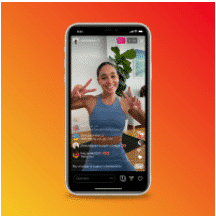
Source: Instagram
Tests for IGTV ads are underway as well. These ads can last up to 15 seconds and appear after someone clicks to watch the full IGTV video. On par with YouTube, 55% of ad revenue is shared with the creator. In addition to ads, Live Shopping tools now let creators and brands tag products during live videos.

Source: Instagram
These changes come as competition to retain creators heats up between platforms. They also cater to a cohort of “specialized” creators who monetize their audiences by offering valuable content, rather than featuring valuable products and experiences in their content. It’s why many are shying away from the label influencer in favor of the term creator, or even ambassador.
Brand partnerships will still remain an important source of revenue, but they’ve already become a lot less transactional. Expect to see some fine-tuning in the Brand Collabs Manager from Instagram (and Facebook).
4. Instagram Shops set brands up to cash in on conversions
Instagram Shops promise to make it easier for brands to make money, too. Shops let businesses create a storefront directly in the app, so people can buy without the need to visit a website. By eliminating this friction, brands should be able to drive significantly higher conversions and sales.
In May, Instagram and Facebook launched a phased rollout to businesses globally. The plan is for the shopping experience to eventually be integrated across all of Facebook’s apps. Once complete, it will mean that when someone puts something in their cart on Facebook, they can check out later on Instagram using stored credit card info or Facebook Pay (which will likely be integrated, too).

Source: Facebook
To improve discoverability, Instagram will soon have a dedicated Shopping tab, like the Explore tab, which already features a shopping section. Accounts with shops have a View Shop button on their profiles, as well as a shop tab. Businesses can customize how collections appear, connect loyalty programs, and benefit from the platform’s built-in AI to create personalized experiences.
There are now more ways to spend money in Stories, too. In addition to product tags, companies can share gift card, food order and donation Stickers.
Set up Instagram Shopping so you can sell your products.
5. Shopping and advertising get AI-powered upgrades
More people shopping across Instagram and Facebook means more data. And more data brings the company closer to its vision of “making anything shoppable while personalizing to individual taste.”
To make anything shoppable, the Facebook engineers have developed an A.I called GrokNet that can automatically tag the products in a business’s catalog in seconds. The A.I., which is already used on Facebook Marketplace, can scan photos, identify attributes such as colour and style, cross-reference with catalogs, and suggest descriptions. On the flip side, this data is used to deliver better search results and targeted ads to users.
Rotating View is another A.I. project that aims to enhance social shopping. The feature, which allows people to create 3D-like images, is currently being tested on Marketplace. Maybe it will crop up on Instagram, too.
Instagram may soon introduce ads that use augmented reality to let people “try on” beauty products or preview furniture in their homes. Facebook already offers an AR ad format, and Zuckerberg recently announced more developments are on the horizon.
Read our complete guide on how to advertise on Instagram.
6. Instagram Guides accompany the rise of “info-social”
Brands and influencers often get asked for recommendations, from “where should we eat in Marrakech?” to “how do you talk to your kids about climate change?”. In the past, these requests have been handled by referring followers to highlights or blog posts. Now guides can be created directly on Instagram.
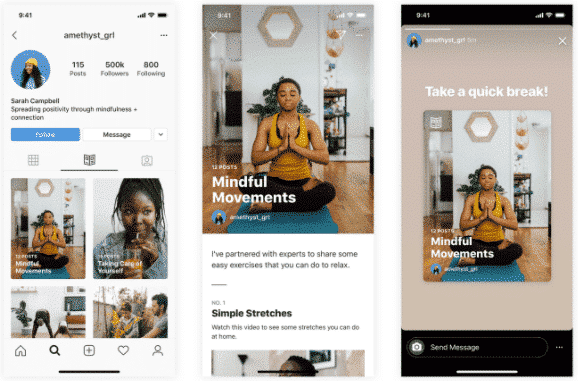
Source: Instagram
According to Instagram head Adam Mosseri, guides were initially developed for travel, but that idea was curtailed by the coronavirus outbreak. Instead, they launched under the theme of wellbeing, with more themes coming up. Instagram recently assembled a racial justice resource guide, too.
Guides have their own devoted tab on profiles, and can be shared to Stories or appear in the Explore tab. They can include curated posts and videos with added notes and tips.
There’s a growing appetite for informative social content. On TikTok, educational videos are surging in popularity, especially in China, with a reported 14 million “knowledge-based” posts created last year. In the United States, career coaches, personal finance experts, and fitness experts are finding success on the app.
On Instagram, everything from “practice accounts” to doctor and nurse micro- and nano-influencers are popular, proving that engaged communities are much more valuable than high follower counts.
7. Values take center stage
Authenticity is a big buzzword in the influencer industry. But it’s not just an influencer trend. Consumers increasingly demand authenticity from brands, too, especially in the form of transparency.
As brands and influencers use their platforms to take a stand, promote values, and support causes, transparency will be more necessary to retain authenticity. For example, sustainable beauty brand Elate Cosmetics goes into great detail to explain the eco-attributes of its products and practices.
Influencers will share more about their decision making in general, and be more upfront about why they partner with specific brands. To maintain trust, disclaimers and clear labelling between spon-con and regular posts will be necessary, particularly in Stories.
With social advocacy on the rise, Instagram has added several fundraising tools, including live fundraisers and donation stickers. The company is also reportedly testing the option to add fundraisers to profiles. Nonprofits already have access to account Donate buttons.
Instagram is also adding context to posts from high-reach accounts. In April, the company started piloting a feature that shows location and where followers are based on posts from these accounts.
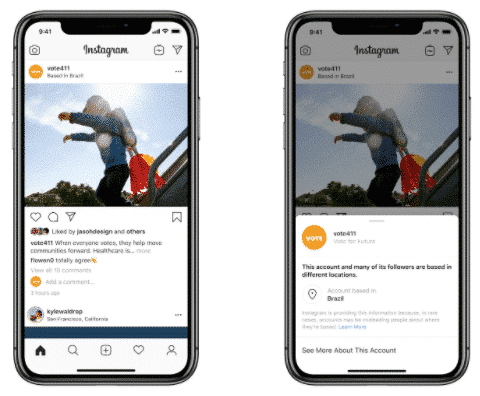
Source: Facebook
8. TikTok, Twitter, and Giphy invade Instagram
The days when Instagram was only a place for filtered images are long gone. Instagram’s feed now features everything from memes and Twitter takes to TikTok challenges, special effects, music, and more.
To keep up with competition from TikTok and Snapchat, Instagram’s been on a feature-adding bonanza—especially in Stories. The recent acquisition of Giphy, which already sourced 25% of its traffic from Instagram, will add to a collection of interactive features that already includes stickers, filters, and other special effects.
Despite more content variety in the feed, the Instagram aesthetic still creeps in. As Arimeta Diop points on in Vanity Fair: “It’s the end of the iPhone-Notes-App-Apology Era.” Bold typefaces, templates, and hand-drawn sketches have proven more popular, thanks in part to Instagram’s strong design community. Infographics and visual storytelling have taken off, too.
Most cross-platform sharing is up to the users, except when it comes to Facebook’s family of apps. Further integration between Instagram, Facebook, WhatsApp, Messenger—on the front and back end—is looming. Beyond a fully integrated shopping experience, Facebook is developing an option for users to view and reply to Instagram Stories from Facebook.
Facebook is also planning to merge messaging across its apps by the end of this year. Once complete, Instagram users would be able to message friends on WhatsApp and Messenger, even if those friends don’t have Instagram accounts. This level of integration would make the app family comparable with the WeChat, the super app that dominates in China.
Manage your Instagram presence alongside your other social channels and save time using Hootsuite. From a single dashboard you can schedule and publish posts, engage the audience, and measure performance. Try it free today.
By Katie Sehl

